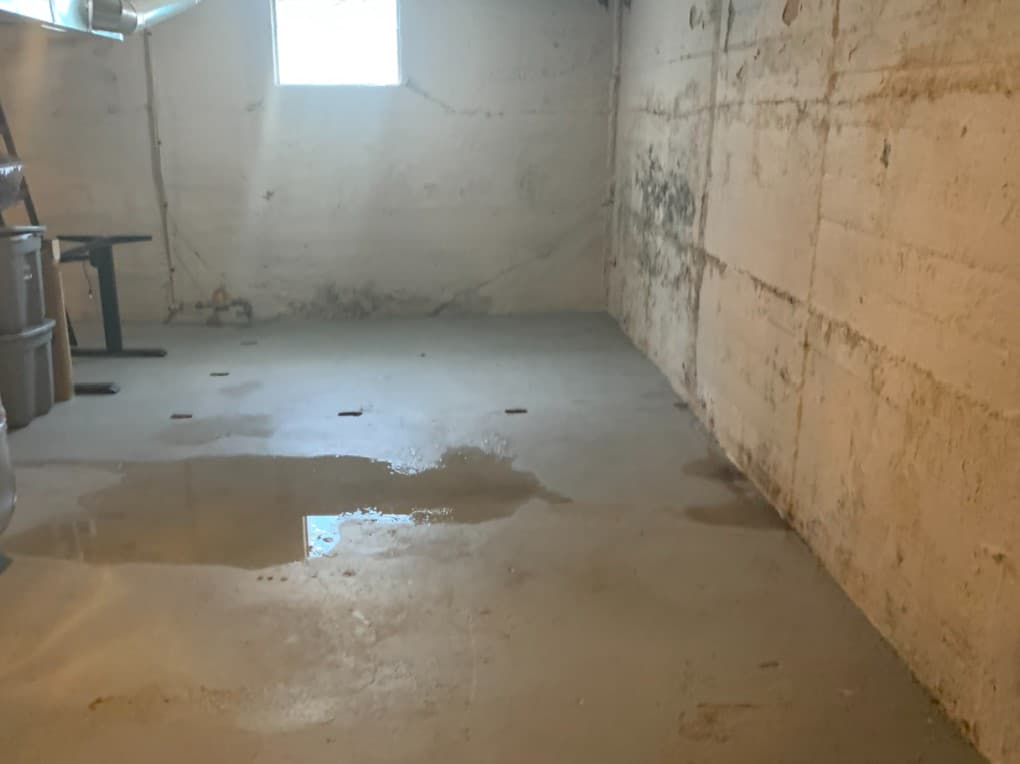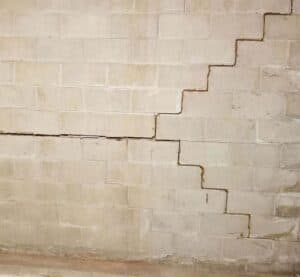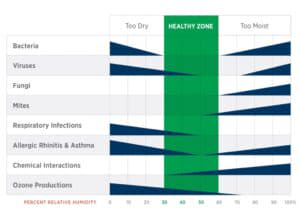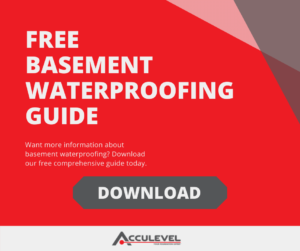What is the Best Solution for Wet Basement Walls?

Unless you’ve installed one of those chic cascading wall fountains in your house, your walls are meant to be dry. And this includes your basement walls; being partially below ground does not equate to being damp.
At Acculevel, we’ve been repairing foundations and waterproofing basements since 1996. We’ve helped more than 35,000 homeowners repair and restore their homes to ideal health and stability. Our goal is help you determine the whole-home solution that best suits your needs, so that it maintains its value for years to come.
In this article, we’re going to discuss what the best solution is for your wet basement walls. Depending on your situation, this could include crack repair, water drainage, or even encapsulation. We’ll review each option and provide you with additional resources, if you want to further explore a particular solution.
Why Are Your Basement Walls Wet?
The first step is determining how – and where- the water is entering your home. The answer may be obvious, if you have a significant crack in one or more walls.
But if your wall appears to be intact, you could be confused (and rightfully so!). The fact is, if there is enough moisture in the ground outside, water can seep directly through your basement wall. This is because all of the materials that form your basement are porous; there are tiny openings in the concrete, brick, or mortar that allows water to squeeze its way in.
We mentioned that water in the ground outside causes leaks. It can also cause the cracks themselves, through hydrostatic pressure. This is our industry’s term for excess water in the soil around your house. The ground can only absorb so much water; additional moisture flows around your home, pushing against it.
Are There Cracks Forming in Your Basement Wall?
Small cracks that may (or may not) be letting in water should be repaired promptly, to prevent them from becoming larger cracks. There are several different repair methods for repairing small foundation cracks, but we only use an epoxy fill method. Over the last 20+ years, we’ve tried a variety of repair options, but epoxy is the only one that meets all of our requirements. It sets quickly, provides a long-lasting seal, yet it’s flexible enough to move with the seasonal expansions and contractions. We warranty this type of crack repair for 5 years.
Large cracks in a basement wall are an indication that the hydrostatic pressure is serious enough to cause significant damage. These breaks in the wall can be a major problem if they are not repaired properly and thoroughly. In the photo below, you can see two different types of cracks have formed.

This photo was taken by an Acculevel project advisor during a free in-home assessment.
Long horizontal cracks can be found in any type of foundation wall, whether it’s constructed with poured concrete, brick, or cinder block. The zig-zag or stair step type of crack only happens in brick or block, because the wall splits along the mortar lines.
Both of these cracks are indications that the wall is starting to bow inward, or buckle. You do not want to procrastinate this type of repair. The worse it gets, the more invasive and expensive it will be to repair. If the wall is bowing less than 2 inches, it can be repaired with carbon fiber straps.
Once you’ve had cracks in the basement walls repaired, it’s time to address the water that’s getting into your home.
You Need Water Drainage if You Have Water Intrusion
If the cracks in your basement are minor and not letting in any water, repairing those cracks may be all you need. But you’re reading this article because your basement walls are wet; that means you have a water intrusion problem.
Water may be an inanimate object, but it acts like a creature of habit. Once water creates a path into your home, it will keep coming back to that weakened area. Eventually it will re-open the original crack(s) or create new ones that connect to the original gaps. Either way? Once you have a wet basement, it’s just a matter of time before you’ll need to install a water drainage system.
There Are Two Major Components to a Water Drainage System
The goal of a water drainage system is to manage and remove water from your home. Water drainage tile is run around the perimeter of your basement to collect the water that gets in. The tile directs the water to a sump pump, which transfers the water back outside through a discharge line. Acculevel installs two different types of drainage, depending on the size and condition of your home’s footer.
You May Also Need to Treat the Side Effects of Water Intrusion
In most situations, a wet basement wall leads to a moldy basement wall. Mold spores are everywhere, and will flourish in a damp basement. Mold is bad enough on its own– it’s a very common allergen that triggers cold-like symptoms in people. But a dark, moist environment also allows for organisms like bacteria and viruses to grow.

This chart demonstrates the findings of a study performed by ASHRAE (American Society of Heating, Refrigerating and Air-Conditioning Engineers)
You can see in the graphic above that the ideal humidity level in your home is 50%. This is when the fewest contaminants can survive. If you have mold in your basement, and it covers more than 10 square feet, the EPA recommends you have the growth treated by a professional.
If it’s only a small amount of mold, or it’s in the early stages of growth, a whole-home dehumidifier may be enough to keep the situation clear.
Encapsulation Can Establish a Clean and Dry Basement
Once water drainage is installed and any biological growth is removed, you may want to add a wall liner to your basement. This process is referred to as encapsulation; a strong inorganic material covers the basement walls from top to bottom.
This liner traps water behind it, so any moisture that comes through the wall will only have one direction to go: down to your water drainage. This is particularly helpful if you want to finish your basement. The encapsulation will make sure the insulation, framework, and drywall stay moisture-free.
And if you have a strong mold allergy, or a compromised immune system, and want to add a layer of protection between you and potential growth? Encapsulation will also prevent that from being an issue. You can learn more about the encapsulation process, and the extremely durable liner material that Acculevel installs in this blog. (We warranty our encapsulation installation for 25 years.)
Want More Information about Waterproofing Your Basement?
There are links to additional articles about the specific products and services we mentioned throughout this blog. If you still have questions, we have the answers! You can find our free and comprehensive homeowner’s guide to basement waterproofing on our website.

This resource is available to any homeowner, no matter where you live. We know how upsetting and frustrating it can be to find something wrong with your home, and not know what you need to do or how to find the contractor you need.
While we’re on that subject, please use our list of questions to ask a contractor when you are meeting with different company representatives. The article explains why you should ask these specific questions, as well as when you should be wary of the answers.
Ready to Schedule An In-home Assessment?
If you do live within our service area (Indiana and portions of the surrounding areas), please call Acculevel at 866-669-3349. Don’t want to talk on the phone? Prefer to have written details about upcoming appointments? Complete our online form instead, and let us know you want to be contacted by text or email.
We’ll schedule an appointment for you with one of our expert project advisors. They’ll come to your home, discuss the issues you’ve noticed, then conduct a detailed inspection of your home. Once our project advisor has completed the review, they’ll sit down and walk you through their findings, best recommendations, and options available to you.
Our goal is to provide you with a whole-home solution; a plan that will meet your needs, help you reach your goals, and keep your home healthy and strong for years to come.
